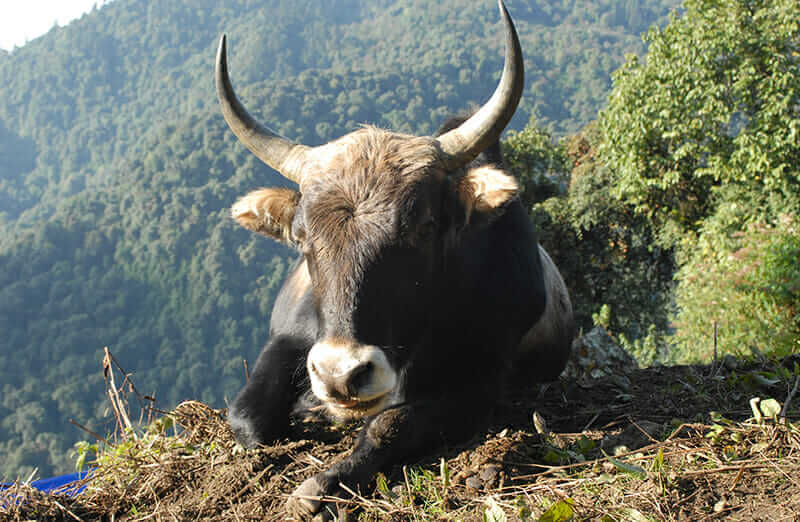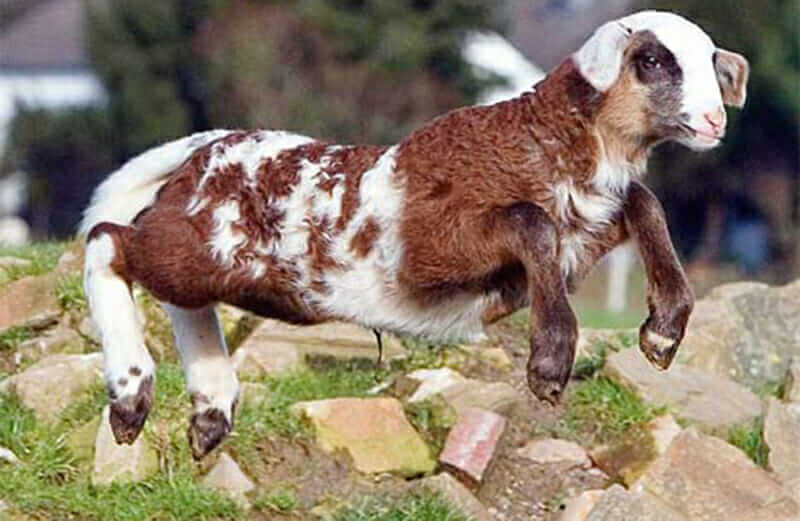10 Farm Animal Hybrids You Didn’t Know Existed
Forget ligers, tigrons and grolar bears (oh my). Plenty of jaw-dropping hybrids can be had at the farm, where cross-species hybrids are more common than you might think.

Beefalo
Ah yes, how fondly we remember the 1970s. A time of afros, Nixon, and of course, the peak of America’s interest in beefalo. English settlers in the American south noticed genetic mixes between American Bison and domestic cattle as far back as 1749, but it would be 100 years until the first intentional hybrids and more than two hundred until beefalo entered the mainstream of American culture. That decade, a peak 6,000 ranchers agreed to raise the fertile hybrid.
Popularity in beefalo has waned since, but the meat still has its fans. Just last year, the American Royal Steak Competition rated a beefalo steak from Merril Cattle Co. as the best in the country for the second year in a row.

Dzo
Dzo are the Tibetan cross between yaks and cattle. Like mules, the male version of the hybrid is infertile, but female dzo, or dzomo, are fertile, allowing for the “back breeding” of three-quarter mixes. The hybrids are larger and stronger than the yaks and cattle of the region, making them ideal pack animals for hauling gear to the base of Mount Everest.

Zubron
We will move on from the cattle hybrids in a second, but we must mention the zubron: a cross between cows and wisent. Oh, and what’s a wisent, wiseguy? Those are European woods bison that once bordered on extinction, but now are on their way to a comeback thanks to reintroduction efforts. So basically, zubron are Europe’s answer to beefalo.
After WWI, many Europeans thought zubron would replace domestic cattle because of their durability and resistance to disease. But scientists didn’t breed the first fertile zubron until 1960, and in 1980 the Polish government discontinued the program because of a lack of interest from state-owned farms. A single herd of Zubron remain in Bialowieski National Park in Poland.

Cama
Exactly who authorized the crossbreeding of a camel and a llama to create the first cama, and then named it Rama? Oh right: the Crown Prince of Dubai.
Camels weigh six times as much as llamas, so suffice it to say that artificial insemination was the only option for researchers in the United Arab Emirates. They succeeded in 1998, creating an animal they hoped would have the wool of a llama with the even temperament of a camel. Rama, to their disappointment, has proven rather moody.

Yakalo
Alberta is apparently the only home where yakalo — the cross of yaks and buffalo — have ever roamed.
A 1926 edition of the Lyon County Reporter describes the successful cross at Wainwright National Park, one of the Canadian national parks created to maintain the population of American Bison (it was later turned into a military base following WWII). The animals reportedly made for great meat and shrugged off the Canadian winters, but for some reason never caught on.

Sheep Goat
Millions of years of evolutionary separation and a mismatched number of chromosomes wasn’t enough to stop one goat at farm in Northern Germany. He jumped a fence for a romantic encounter with a sheep. Usually, such cross-breeding result in nothing or a stillborn, but farmer Klaus Exsternbrink watched his sheep give birth to a perfectly healthy geep named Lisa, pictured above. (You could say shoat, but the word already denotes a baby pig.)
While natural sheep/goat hybrids are extremely rare, scientists have perfected a technique to create them in a lab. More on that in a bit.

Iron Age Pig
Iron Age pigs are an ancient farm animal with a modern appeal. Scientist bred a male wild boar with a Tamworth sow to create pigs resembling ancient paintings, with one unintended consequence: the meat was delicious. The animal’s meat is now a common sight at specialty meat markets across around the world.

Game Bird Hybrids
Birds have a much easier time crossing species lines than mammals, making avian hybrids much more common than mammalian hybrids. Some notable combinations include pheasants and chickens, pheasants and turkeys, and Canada geese mating with just about every other type of geese. Strangely, no one has been able to successfully breed a chicken and a turkey.

Mules and Hinnies
The most common and most practical of all hybrids are mules (the offspring of a male donkey and a female horse) and hinnies (the offspring of a male horse and a female donkey). Ever since George Washington brought mule breeding to America (you read that right), mules have played a primary labor role as work animals and pack animals for their superior strength and endurance over horses. And while they can’t be bred, they can be cloned. In 2003, The University of Idaho succeeded creating the first clone of a hybrid animal — a mule named Idaho Gem.
Chimeras
Strangely enough, there are two ways to create combinations of sheep and goats. The first is the old-fashioned farm mishap, as described as a geep. The other is to mix up the embryos of each animal in a bioengineering lab. The result is a chimera – an animal made of two genetically distinct cells.
Because they have cells tied to each species, sheep/goat chimeras look like sewn together franken pets. The first such chimera in 1985 broke open a world of scientific possibilities, allowing researchers to do such things as insert human cells in animals (like testing human livers cells in mice). Bioethicists remain highly concerned about chimeras, despite their medical potential. Not only does the practice discount the welfare of animals, but some chimeras could become so human that they’d have to be considered as such.
A tough note to end on for a light-hearted listicle, but something to think about. Scroll back up to that sleeping zubron and look at it for a while if you feel the need.
Follow us

This work is licensed under a Creative Commons Attribution-NoDerivatives 4.0 International License.
Want to republish a Modern Farmer story?
We are happy for Modern Farmer stories to be shared, and encourage you to republish our articles for your audience. When doing so, we ask that you follow these guidelines:
Please credit us and our writers
For the author byline, please use “Author Name, Modern Farmer.” At the top of our stories, if on the web, please include this text and link: “This story was originally published by Modern Farmer.”
Please make sure to include a link back to either our home page or the article URL.
At the bottom of the story, please include the following text:
“Modern Farmer is a nonprofit initiative dedicated to raising awareness and catalyzing action at the intersection of food, agriculture, and society. Read more at <link>Modern Farmer</link>.”
Use our widget
We’d like to be able to track our stories, so we ask that if you republish our content, you do so using our widget (located on the left hand side of the article). The HTML code has a built-in tracker that tells us the data and domain where the story was published, as well as view counts.
Check the image requirements
It’s your responsibility to confirm you're licensed to republish images in our articles. Some images, such as those from commercial providers, don't allow their images to be republished without permission or payment. Copyright terms are generally listed in the image caption and attribution. You are welcome to omit our images or substitute with your own. Charts and interactive graphics follow the same rules.
Don’t change too much. Or, ask us first.
Articles must be republished in their entirety. It’s okay to change references to time (“today” to “yesterday”) or location (“Iowa City, IA” to “here”). But please keep everything else the same.
If you feel strongly that a more material edit needs to be made, get in touch with us at [email protected]. We’re happy to discuss it with the original author, but we must have prior approval for changes before publication.
Special cases
Extracts. You may run the first few lines or paragraphs of the article and then say: “Read the full article at Modern Farmer” with a link back to the original article.
Quotes. You may quote authors provided you include a link back to the article URL.
Translations. These require writer approval. To inquire about translation of a Modern Farmer article, contact us at [email protected]
Signed consent / copyright release forms. These are not required, provided you are following these guidelines.
Print. Articles can be republished in print under these same rules, with the exception that you do not need to include the links.
Tag us
When sharing the story on social media, please tag us using the following: - Twitter (@ModFarm) - Facebook (@ModernFarmerMedia) - Instagram (@modfarm)
Use our content respectfully
Modern Farmer is a nonprofit and as such we share our content for free and in good faith in order to reach new audiences. Respectfully,
No selling ads against our stories. It’s okay to put our stories on pages with ads.
Don’t republish our material wholesale, or automatically; you need to select stories to be republished individually.
You have no rights to sell, license, syndicate, or otherwise represent yourself as the authorized owner of our material to any third parties. This means that you cannot actively publish or submit our work for syndication to third party platforms or apps like Apple News or Google News. We understand that publishers cannot fully control when certain third parties automatically summarize or crawl content from publishers’ own sites.
Keep in touch
We want to hear from you if you love Modern Farmer content, have a collaboration idea, or anything else to share. As a nonprofit outlet, we work in service of our community and are always open to comments, feedback, and ideas. Contact us at [email protected].by Sam Brasch, Modern Farmer
January 16, 2014
Modern Farmer Weekly
Solutions Hub
Innovations, ideas and inspiration. Actionable solutions for a resilient food system.
ExploreExplore other topics
Share With Us
We want to hear from Modern Farmer readers who have thoughtful commentary, actionable solutions, or helpful ideas to share.
SubmitNecessary cookies are absolutely essential for the website to function properly. This category only includes cookies that ensures basic functionalities and security features of the website. These cookies do not store any personal information.
Any cookies that may not be particularly necessary for the website to function and are used specifically to collect user personal data via analytics, ads, other embedded contents are termed as non-necessary cookies.

Kevin Hart was telling the truth a Zubron did run across the street LOL… People should stop trying to play God
I actually own 30 yak/cattle hybrids that have been documented by DNA analysis through GeneSeek. I have them in Colorado where I train them to pack in the West Elk Wilderness. Yaksmatter.com.
Did deer cross goat or sheep?
How about a deer/goat cross? Haven’t seen any of these yet.
Old Hickory Beefalo Farm ( in the beefalo section above) has also been raising Beeyakalo. A Hybrid of beef, yak and bison.
Anything on the successful breeding of a yak and a muskox ?
Does anybody know if the offspring of deer and cows can reproduce??
It’s so endearing you ended the article with a hybrid word, “listicle.”
There actually has been a turkey x chicken hybrid.
https://www.sciencenewsforstudents.org/article/churk-not-thanksgiving
The sheep goat is called a geep